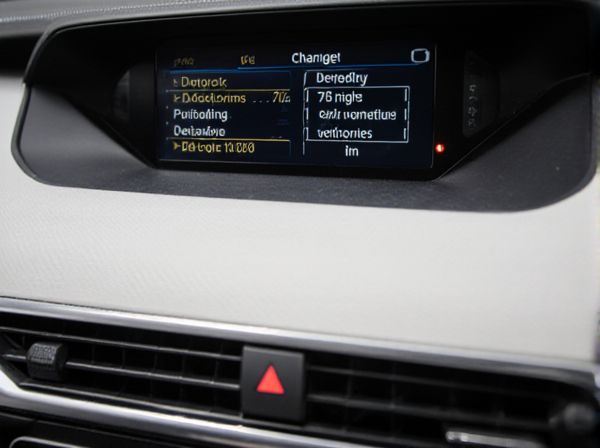
Photo illustration: ECU Diagnostic Display vs Warning Lamp
An ECU diagnostic display provides detailed information about your vehicle's system status and fault codes, allowing precise identification of issues for effective troubleshooting. In contrast, a warning lamp offers a simple visual alert to indicate a problem but lacks specific diagnostic data. Understanding the difference helps you respond appropriately, ensuring timely maintenance and avoiding potential damage.
Table of Comparison
| Feature | ECU Diagnostic Display | Warning Lamp |
|---|---|---|
| Function | Detailed fault codes and system status from the Engine Control Unit (ECU) | Simple visual alert for immediate issues |
| Information Depth | Comprehensive data for precise diagnostics | Basic indication of malfunction or hazard |
| User Interaction | Requires diagnostic tool or interface to interpret | Instant recognition without tools |
| Examples | Codes for engine misfire, sensor failure, emission errors | Check engine light, oil pressure lamp, brake warning light |
| Purpose | Assist mechanics in troubleshooting and repair | Notify driver immediately about critical problems |
Introduction to Vehicle Diagnostic Systems
Vehicle diagnostic systems utilize ECU diagnostic displays to provide detailed fault codes and real-time sensor data, enabling precise identification of issues. Warning lamps offer a simplified visual alert on the dashboard, indicating the presence of a problem without specific diagnostic information. Advanced ECU diagnostics integrate with onboard systems to monitor engine performance, emissions, and safety features, enhancing vehicle maintenance and troubleshooting accuracy.
What is an ECU Diagnostic Display?
An ECU Diagnostic Display is an advanced interface that communicates real-time engine control unit (ECU) data, allowing drivers and technicians to monitor vehicle performance parameters such as engine temperature, RPM, and fault codes. Unlike a warning lamp that provides simple alerts for system malfunctions, the ECU Diagnostic Display offers detailed diagnostic information essential for accurate troubleshooting and preventive maintenance. This display enhances vehicle diagnostics by presenting comprehensive data directly from the ECU, facilitating timely and precise interventions to maintain optimal vehicle health.
Understanding Warning Lamps in Modern Vehicles
Warning lamps in modern vehicles act as immediate visual alerts on the dashboard, indicating specific issues detected by the ECU (Engine Control Unit) such as engine malfunctions, oil pressure drops, or brake system failures. Unlike the detailed data provided by an ECU diagnostic display, warning lamps are designed for quick recognition and driver awareness, using standardized symbols and colors to prioritize safety-related concerns. Understanding the meaning behind each warning lamp is crucial for timely maintenance and preventing further vehicle damage.
Key Differences: ECU Diagnostic Display vs Warning Lamp
The ECU diagnostic display provides detailed fault codes and real-time data, enabling precise identification of vehicle issues, whereas the warning lamp offers a simple, immediate alert for malfunctions without specific information. ECU diagnostic displays require specialized tools to interpret data, facilitating comprehensive troubleshooting, while warning lamps serve as basic indicators alerting drivers to potential problems. The key difference lies in depth of information: ECU displays enable targeted repairs, whereas warning lamps prompt general awareness of system malfunctions.
Advantages of ECU Diagnostic Displays
ECU diagnostic displays provide real-time, detailed data on engine parameters, allowing precise identification of issues before they escalate. Unlike warning lamps that signal general problems, these displays offer specific fault codes and sensor readings for targeted troubleshooting. This functionality enhances maintenance efficiency, reduces diagnostic time, and minimizes costly repairs.
Limitations of Warning Lamps
Warning lamps provide a basic alert system for vehicle malfunctions but lack detailed diagnostic information, limiting their effectiveness in identifying specific issues. They often fail to indicate the severity or exact cause of a fault, leading to potential misinterpretation and delayed repairs. Unlike ECU diagnostic displays, warning lamps cannot deliver real-time data or error codes necessary for accurate troubleshooting and maintenance.
Impact on Vehicle Maintenance and Repairs
ECU diagnostic displays provide detailed fault codes and real-time data, enabling accurate identification of vehicle issues and reducing diagnostic time during maintenance and repairs. Warning lamps offer basic alerts that indicate problems without specific information, often leading to broader inspections and longer repair times. Utilizing ECU diagnostic displays enhances efficiency and cost-effectiveness in vehicle upkeep by pinpointing precise faults early.
Driver Experience: Display vs Lamp Alerts
ECU diagnostic displays provide detailed fault codes and real-time data, enhancing driver awareness and facilitating quicker troubleshooting compared to simple warning lamps. Warning lamps offer basic alerts with limited information, which can leave drivers unsure about the severity or cause of the issue. Display interfaces improve the driver experience by delivering clear, actionable insights, reducing uncertainty and enabling proactive vehicle maintenance.
Future Trends in Automotive Diagnostics
ECU diagnostic displays are evolving with integration of real-time data analytics and AI-powered fault detection, offering precise and actionable insights beyond traditional warning lamps. Future automotive diagnostics will leverage connected vehicle technology, enabling predictive maintenance and remote monitoring through enhanced ECU interfaces. Advanced visualization and user-friendly displays aim to reduce driver distraction while improving diagnostic efficiency in modern vehicles.
Choosing the Optimal System for Your Vehicle
Choosing between ECU diagnostic display and warning lamps depends on the level of detail required for vehicle maintenance. ECU diagnostic displays provide comprehensive real-time data and error codes crucial for precise troubleshooting, while warning lamps offer immediate, easy-to-understand alerts for urgent issues. Prioritizing an ECU system enhances proactive care and accurate diagnostics, ideal for advanced vehicle management and timely repairs.
 caratoz.com
caratoz.com